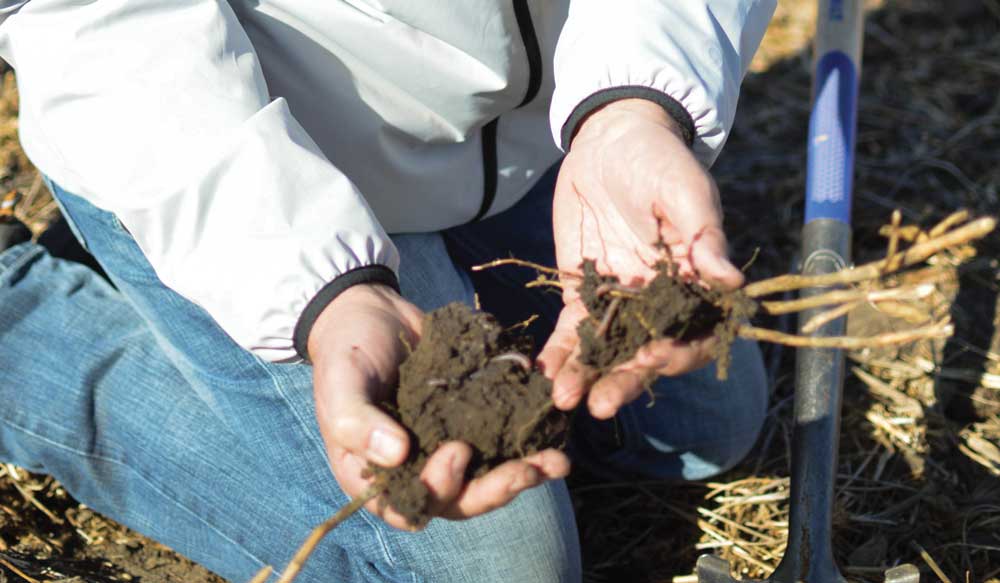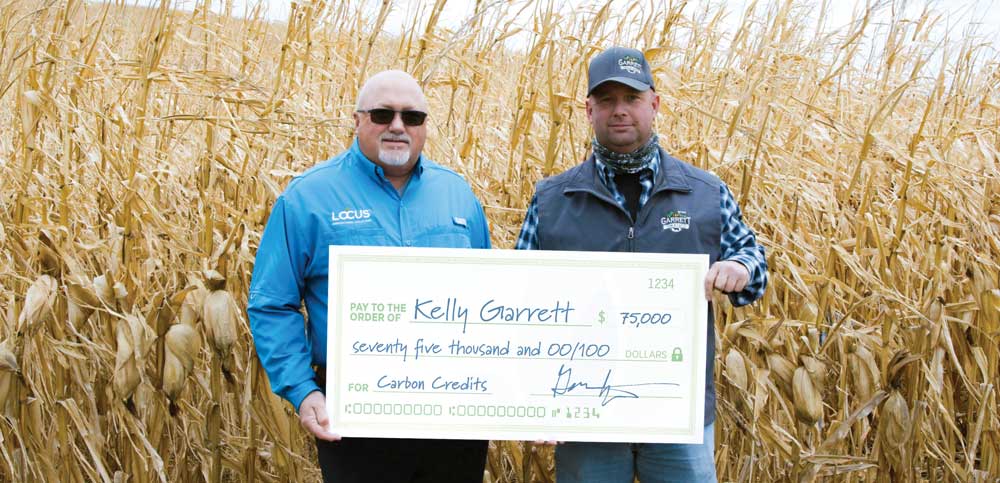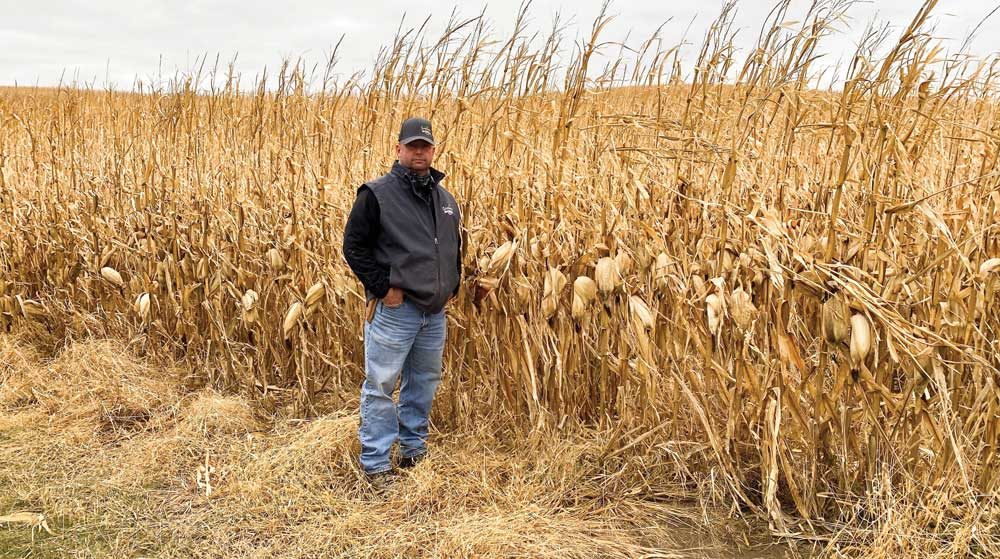Pictured Above: DIVERSIFYING PROFITS. As a repeat National Corn Growers Assn. high-yield winner, Arion, Iowa, no-tiller Kelly Garrett is no stranger to exploring new ways to push for higher yields, more efficiency and a better bottom line. He’s now added carbon farming to his practices.
After many years of farming, it can be a pleasant surprise to develop a new profit center for the farm — let alone more than one.
But that’s exactly what’s happened for Kelly Garrett who has added a few carbon-oriented revenue streams to his business portfolio. He not only raises crops, but also distributes a carbon-rich plant nutrient that is a byproduct of soybean processing, uses a yield-enhancing soil “probiotic” technology that accelerates both yield and carbon sequestration and sells carbon credits from his current practices to big business on the carbon marketplace.
Garrett, along with his wife Amber and their sons Connor, Colin and Cael — and in partnership with his parents, Gene and Cathy — farms 6,200 acres of mostly corn and soybeans, along with some winter wheat, in Arion, Iowa. In addition, Garrett Land & Cattle, located in the western part of the state just about an hour northeast of Omaha, Neb., includes a 500 head cow/calf operation.
Arion receives an equal amount of rain and snow every year (about 33 inches apiece), and while most of Garrett’s land is not irrigated, he did install Netafim drip irrigation on 400 acres in the fall of 2015. Garrett’s use of irrigation is strategic, as he generally uses those acres to compete for top corn yields in the National Corn Growers Assn.’s annual yield contests.
NO-TILL TAKEAWAYS
-
In cold northern climates, drilling or planting cover crop seed usually results in better establishment than aerial application does.
-
Narrower rows can be beneficial in terms of weed suppression as well as higher yields, especially in determinate crops.
-
No-tillers are well-positioned to be able to capitalize on consumers’ growing interest in spending money with companies that are carbon-neutral
In each year from 2016-2019, Garrett took first place in the no-till irrigated corn category for Iowa. In 2019, his entries of 357 bushels, 325 bushels and 299 bushels took 1st, 2nd and 3rd place in Iowa and his top entry also took 2nd place in the nation.
Liquid Carbon
As an NCGA winner, Garrett is accustomed to seeking any edge that will help him push yields higher, improve efficiency or otherwise boost the bottom line.
In 2016, Garrett got the opportunity to begin hauling ingredients for Feed Energy, a liquid feed company based in Des Moines.
Through a process called acidulation, Feed Energy turns a soybean byproduct into a liquid feed for 75 million hogs and poultry, mostly in Minnesota, Iowa and South Dakota. While hauling these materials for Feed Energy was in and of itself a good way to diversify his operation, he realized it represented an even more powerful opportunity.
“As part of the acidulation process, 50% of the output is a process water we call ‘Plant Food,’” Garrett says, explaining that 500 gallons contains the equivalent of $100 of dry fertilizer with a nutrient analysis of 14-105-24 and 105 sulfur. In addition, that same 500 gallons has 170 pounds of organic carbon.
Feed Energy produces 25 million gallons of this plant food. Garrett uses 3 million gallons per year on his farm and sells or custom-applies the rest for friends and nearby farmers.
“It’s an inexpensive fertilizer for us and it really improves our carbon stored because of the carbon in it,” he says.
Carbon Marketplace
Starting in 2020, Garrett took the next step in utilizing the carbon stored in his ground when he became one of the first farmers in the U.S. to actually get paid for carbon sequestration via the CarbonNOW program from Locus Agricultural Solutions (Locus Ag), which helped him sell carbon credits in the Nori carbon credit marketplace.

TEST AND VERIFY. Soil tests are but one part of carbon sequestration programs. Validation of conservation practices is also done by way of federal crop records and FieldView data, which are verified by an independent third party.
He signed up for the program in May 2020, and in November received a $75,000 payment for 5,000 carbon credits that were purchased by Shopify for $15 apiece. An additional 2,210.5 credits were purchased by other buyers for $33,157.50. He still has 15,534.5 credits on the marketplace, representing another potential windfall of $233,017.50 if they sell at the same unit price.
He got involved with the pilot program when Locus AG reached out to Xtreme Ag, a website he’s involved with that is targeted to high-yield corn growers (www.XtremeAg.farm).
“They were looking for early adopters willing to sign up for the program. As it turns out, I knew Shane Head, the vice president of environmental platforms at Locus AG — he used to be the grain buyer I dealt with at Cargill, and we had a really good relationship so it was easy for me to put a lot of faith and trust in Locus.”
As the first farmer to go through the program, Garrett says Locus AG was looking for someone willing to work through the details of the new and evolving carbon space with them.
“I knew that by going with Locus AG’s CarbonNOW program, I was going to be one of the first farmers in the nation to actually get paid for carbon credits. There’s a lot of advertisements. There’s a lot of talk. The reality is other carbon programs haven’t accomplished anything yet; CarbonNOW has. I was the first to get a big check.”
Through CarbonNOW, Locus AG leads farmers through the process of collecting farm practice data and documentation needed to generate carbon credits. For the Nori marketplace, credits are based on the USDA’s COMET-Farm voluntary carbon accounting systems for farms and ranches, which calculates the environmental benefits of various conservation practices.
“It took about 3-4 months to get everything done, but if a producer were to do it today it wouldn’t take that long,” he says, adding that during that time, he and his bookkeeper dedicated about 55 hours to entering data, doing paperwork and answering questions about their practices.
Garrett didn’t have to adopt any new practices for his credits because the Nori marketplace along with a third-party auditor, in this case Aster Global, uses federal crop records and FieldView records to validate farming practices for the past 10 years. An algorithm was then used to identify how many carbon credits the practices have generated based on the 2015-2019 cropping years.
“We’re 100% no-till with cover crops and Plant Food and we put our cows out on corn stalks; and we didn’t change anything. This was one of those few times in life when everything just kinda came together,” he says.
It’s important to note that payments for this 5-year lookback period that Garrett received was limited to participants in Nori’s pilot program. According to Karthik Karathur, president of Locus AG, the company is basing their carbon measurement methodologies on a protocol established by Climate Action Reserve, a registry based in California that establishes standards for carbon offset projects.
“The Climate Action Reserve methodology only lets you go back 2 years because when you offset it’s about the carbon that you’re putting into the ground now, not what you put in 5 years ago,” says Karathur. So going forward, farmers who sign up for CarbonNOW could expect payments for carbon removed over the last 2 years, assuming the conservation practices were started in the past decade.
“Ultimately it is about practice change and you’re allowed to monetize a practice change for 10 years,” says Karathur. So if a farmer adopted a qualifying practice in 2011, for instance, he would be able to claim credit for it until 2021, he says.
While Garrett doesn’t know when the rest of his carbon credits will sell, he sees a growing demand as he looks into the future.
“I see the carbon market becoming a normal source of diversified income,” he says.
How Does Rhizolizer Duo Help Sequester Carbon?
According to Paul Zorner, chief agronomist for Locus AG, Rhizolizer Duo is unique because it promotes a fungal-dominant system in which soil organisms feed on exudates or organic matter and convert it to body mass rather than just emit as CO2.
“A plant is a natural carbon pump,” he says, adding that plants take CO2 from the atmosphere and through photosynthesis build fruits, leaves and roots. “Any normal plant will also exude about 30% of that photosynthate out through its root system. It’s literally trying to feed the soil microbes.
“Plants need a healthy root microbiome. It’s been shown that a plant’s productivity is a function of its own genetics, its environment, and its nutrition, but also of its microbiome; and that there’s literally a metabolic signaling going on between the plant and the microbiome signaling that all systems are go.
“But if there’s a hole in that functional system, not everything’s working. It’s like buying a tricked-out Ford F-150 and leaving the steering wheel off.
“We selected the organisms in Rhizolizer Duo very carefully — a filamentous fungi called Trichoderma and a beneficial bacteria called Bacillus — and we’re seeing them work synergistically to add functionality to soils that aren’t fully optimized in terms of the interactions that the plant needs.”
Rhizolizer Duo is co-applied with a microbial food source containing a proprietary blend of micronutrients to help get the microbes started and maximize efficacy.
“So all that combines together to ultimately change the soil microbiology, positively impact the crop productivity and populate the soil with microbes that are going to convert it to organic matter, as opposed to just releasing it as expiring CO2 into the atmosphere,” says Zorner.
Soil samples are done regularly to verify carbon levels and practices are re-validated every 3-5 years, but this isn’t an issue for Garrett.
“Number one, I’m not going to change my practices because I believe they’re correct,” he says. “Number two, my practices sequester more carbon than other practices, so financially it would be a mistake to start tilling or stop using cover crops.”
While carbon markets have failed in the past, Garrett believes this time around things are different. “In the past, the companies that were involved in the carbon markets were in it for their own gain, not the gain of the world or the environment,” he says.
“And now the carbon program is growing in part because farmers want to do a better job. But also consumers want to spend their money where there’s a carbon-neutral footprint. So the carbon program now is coming from the right place.”
Foundational Practices
Capturing carbon has been in the works for many years on the Garrett farm. With portions of their land being no-tilled for years, the Garretts achieved 100% no-till in 2012.
“We had been no-tilling soybeans as well as corn into soybean stubble for years but had never no-tilled corn-on-corn,” says Garrett. “We wanted to do more corn-on-corn and the NRCS wanted us to no-till those acres for our conservation program. So we put some row cleaners on the planter and we’ve been 100% no-till ever since.”
For corn, he uses a 24-row John Deere 1770 planter on 30-inch spacings with central commodity fill; Yetter row cleaners; and Precision Planting’s DeltaForce down pressure, FlowSense and electric seed units.
In partnership with Integrated Ag Solutions, Garrett is developing an attachment to apply more nitrogen (N) in a 2-by-2-inch configuration beside the row at planting. The new units will allow him to put N right inside the row.
“The closing wheels are plastic so the nitrogen won’t be corrosive on them. And the plastic closing wheels can help incorporate the nitrogen to save it. Especially in a no-till environment, if the nitrogen gets on the residue, it’s kind of tied up and lost. So we want to make sure we get it on the soil, right inside the row.”
With the goal of cutting down on up-front nutrients, Garrett typically applies N, potassium (K) and boron (Rio Tinto’s Solubor, suspended in the N) with the 2-by-2 applicator on the planter. He also applies a micronutrient package in-furrow, the makeup of which varies depending upon soil type and price.
During the growing season, Garrett sidedresses additional nutrients based on tissue samples and crop removal of 300 bushels of corn, though he’ll push higher if he believes the crop has the potential to yield more.
In general, Garrett applies a total of 0.7 pounds an acre of N on high-yielding areas plus 1,000 gallons of the acidulated plant food from Feed Energy and 0.8 pounds of K per bushel, give or take, depending upon yield goal.
Corn is 100% variable-rate seeded based on yield maps. The higher-yielding areas are usually at about 32,000 seeds an acre, and with drip irrigation he goes to about 40,000 — though he’s even had some acres at 50,000 in 2020.
“Unfortunately, that portion got hit hard with the derecho and got blown down,” he says. “For a dryland setting, 32,000 is the top end and 24,000 is the bottom end, based on yield.”
All of Garrett’s acres were affected by the 2020 derecho. In fact, for the first time in years, he didn’t have an NCGA entry because of the hail and wind damage.
His irrigated acres got hit by hail and were in the worst shape of any of his fields. “Getting knocked over just shut the plants down and they just didn’t reach their potential,” he says.
To harvest those acres, he used a 15-inch Gehringhoff head, which he says did a great job of lifting up the flattened corn stalks because “the snoots are narrower and closer together and the reel features progressive technology that helped get the corn off the ground.”

CASHING IN ON CARBON. Arion, Iowa, no-tiller Kelly Garrett is among the first farmers in the U.S. to actually get paid for carbon credits, so far receiving $108,157.50 for carbon credits that were purchased for $15 apiece. He still has 15,534.5 credits available.
Despite the challenges and lack of a record-breaking yield, harvest overall was still decent and made about 200 bushels per acre.
For soybeans, Garrett has been using a 16/31 1790 Deere planter on 15-inch spacings. Seeding populations are usually around 140,000 but he’s been researching populations as low as 80,000. “I want to put out as few seeds as possible,” he says.
In the past, Garrett planted wheat in 15-inch rows, but weed control “could be an issue when the wheat dried down and the sun would hit the earth and weeds would germinate.” So in 2020, Garrett purchased a Deere 1990 drill set on 10-inch rows, which Garrett says produces a lush, thick stand that will help with weed control.
“Wheat is a determinate crop, and in order to get more yield, you need more heads per acre, which means getting more seeds out there. We needed to narrow up the rows in order to do that.”
Garrett says he also plans to use the 1990 to do some 10-inch soybeans starting in 2021.
Covering Up
The Garretts have been adopting cover crops on more and more acres over the years, using either bin-run wheat or cereal rye, depending upon what’s available.
“We started small with cover crops. In 2012, they were a pretty minor part of our operation but we’ve grown our cover crop acreage as we’ve come to understand how they work and what they do,” he says.
“We always want a crop growing to convert plant-available nutrition. And with the cow/calf herd that we have, it’s also nice fall pasture when it comes up.”
He seeds cereal rye at about 50-60 pounds per acre, no matter the following crop. But there are definite limitations.
“We use cover crops extensively on winter wheat and on corn that is chopped for silage,” he says. “We’re starting to use them on our early soybean acres, but we don’t seed them on all the corn-stalk acres because in western Iowa it’s difficult to get them planted early enough for decent germination.”
Garrett has tried aerial applications to get them seeded earlier in the season, but he wasn’t satisfied with the seed-to-soil contact. “I really want to be able to drill them in or plant them in to get a better response,” he says.
In the past, he planted cover crops with his Deere 1790 planter but he’s now using the Deere drill. “We’ll be able to use the drill on more acres, especially after the early soybeans,” he predicts.
Garret used this drill for the first time this summer and fall but says he only seeds cover crops if they have time to get established. “Currently if it gets too cold for them to germinate — when the soil gets to about 55 F or colder — I stop planting them. We’re still researching how to do it better.”
In the spring, Garrett plants his cash crops “green” into the covers, terminating the cover crop after planting corn but before planting soybeans, usually within about a week.
Going Forward
While the CarbonNOW program currently helps farmers get payments for carbon removed over the past 2-5 years depending on carbon market, future carbon sequestration is contingent upon additional practices that can accelerate the process.
For many no-tillers, it may seem like there aren’t many new practices to add, but one practice Garrett is adopting is the use of a naturally occurring microbial soil “probiotic” from Locus AG called Rhizolizer Duo, which the company says can help boost carbon sequestration by 2-3 tons per acre. The liquid product is comprised of two living microorganisms, combined with a microbial food source, that colonize crop roots and promote early root development. In addition to sequestering more carbon, Rhizolizer Duo also enhances nitrogen uptake and improves yields.
Before the 2020 derecho hit, Garrett actually used Rhizolizer Duo on a trial basis though the drip system on his irrigated acres and saw immediate results.
“Before the storm hit, we thought we had a pretty special field of corn and I can tell you from past experience that nitrogen applied through the drip doesn’t become plant-available soon enough. So when tissue samples showed the nitrogen levels dropping I started looking for a different way to provide that field a boost.
“An agronomist I work with suggested we try some Rhizolizer Duo because he thought perhaps the nutrients were getting tied up in the soil and maybe the Rhizolizer Duo would help.”
After taking his weekly tissue sample, Garrett applied Rhizolizer Duo through the drip.
“The next week’s sample showed that the nitrogen levels in my corn increased by 12%. That’s a huge jump and the only thing we did different was put the Rhizolizer Duo through there. So I believe the Rhizolizer Duo helped with the carbon and helped with the microbes in the soil and made more nitrogen available.”
Garrett says he will start using Rhizolizer Duo on all of his acres starting in 2021 and is hoping to generate additional carbon credits from its ability to supercharge carbon sequestration.
Always one to keep pursuing ever higher goals, Garrett is hoping Rhizolizer Duo will also lend an assist in this one: breaking the Iowa state corn yield record.
“The current Iowa state record of 442 bushels was set in 2002 by Francis Childs and we’re going to try to beat it next year. We’ll need some luck and Mother Nature will have to help out, but Rhizolizer Duo is going to play a part.”








Post a comment
Report Abusive Comment